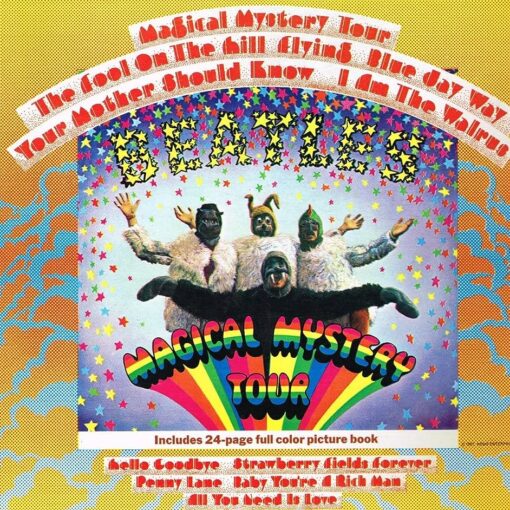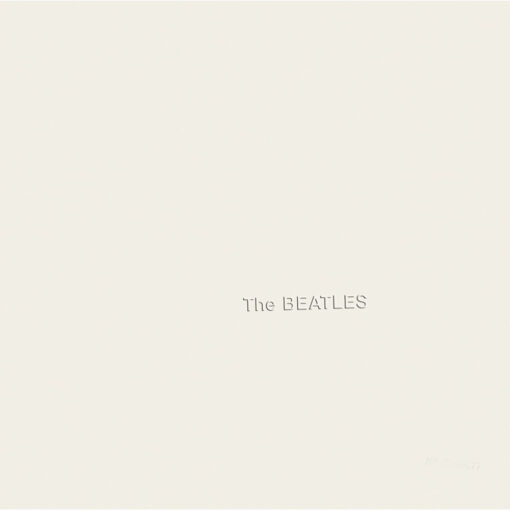- Published in 1967
- Author: Lennon/McCartney
- Track 8 on “Magical Mystery Tour“
- Track 1 on “The Beatles 1967-1970” (Blue Album)
JOHN 1968: “Strawberry Fields was a place near us that happened to be a Salvation Army home. But Strawberry Fields– I mean, I have visions of Strawberry Fields. And there was Penny Lane, and the Cast Iron Shore, which I’ve just got in some song now, and they were just good names– just groovy names. Just good sounding. Because Strawberry Fields is anywhere you want to go.”
PAUL 1974: “That wasn’t ‘I buried Paul’ at all– that was John saying ‘Cranberry sauce.’ It was the end of Strawberry Fields. That´s John´s humor. John would say something totally out of sync, like cranberry sauce. If you don´t realize that John´s apt to say cranberry sauce when he feels like it, then you start to hear a funny little word there, and you think, ‘Aha!’”
JOHN 1980: “Strawberry Fields is a real place. After I stopped living at Penny Lane, I moved in with my auntie who lived in the suburbs… not the poor slummy kind of image that was projected in all the Beatles stories. Near that home was Strawberry Fields, a house near a boys’ reformatory where I used to go to garden parties as a kid with my friends Nigel and Pete. We always had fun at Strawberry Fields. So that’s where I got the name. But I used it as an image. Strawberry Fields Forever. ‘Living is easy with eyes closed. Misunderstanding all you see.’ It still goes, doesn’t it? Aren’t I saying exactly the same thing now? The awareness apparently trying to be expressed is– let’s say in one way I was always hip. I was hip in kindergarten. I was different from the others. I was different all my life. The second verse goes, ‘No one I think is in my tree.’ Well, I was too shy and self-doubting. Nobody seems to be as hip as me is what I was saying. Therefore, I must be crazy or a genius– ‘I mean it must be high or low,’ the next line. There was something wrong with me, I thought, because I seemed to see things other people didn’t see. I thought I was crazy or an egomaniac for claiming to see things other people didn’t see. I always was so psychic or intuitive or poetic or whatever you want to call it, that I was always seeing things in a hallucinatory way. Surrealism had a great effect on me, because then I realized that the imagery in my mind wasn’t insanity; that if it was insane, I belong in an exclusive club that sees the world in those terms. Surrealism to me is reality. Psychic vision to me is reality. Even as a child. When I looked at myself in the mirror or when I was 12, 13, I used to literally trance out into alpha. I didn’t know what it was called then. I found out years later there is a name for those conditions. But I would find myself seeing hallucinatory images of my face changing and becoming cosmic and complete. It caused me to always be a rebel. This thing gave me a chip on the shoulder; but, on the other hand, I wanted to be loved and accepted. Part of me would like to be accepted by all facets of society and not be this loudmouthed lunatic musician. But I cannot be what I am not.”
About “Strawberry Fields Forever”
“Strawberry Fields Forever” was released on 13 February 1967 as a double A-side single with “Penny Lane“. The song was a departure from the group’s previous singles and offered a new listening experience for the contemporary pop audience. The song initially divided music critics and the group’s fans, but it had a significant impact on the emerging psychedelic genre. Likewise, the accompanying promotional video is recognized as a pioneering work.
The song was inspired by Lennon’s childhood memories of playing in the garden of Strawberry Field, a Salvation Army children’s home in Liverpool. In November 1966, the band spent 45 hours in the studio, spanning five weeks, creating three versions of the song. This final recording combined two different versions, which differed in tempo, mood, and key. Featuring reverse-recorded instrumentation, Mellotron flute sounds, an Indian swarmandal, tape loops and a fade-out/fade-in coda, George Martin’s arrangement features cello and brass. The band used experimental techniques like reverse effects, jump-cuts, and superimposition for the promotional film.
This was the first song the Beatles recorded after the completion of Revolver it was intended to be included in their upcoming publication Sgt. Pepper’s Lonely Hearts Club Band. The group was forced to release the single as a result of pressure from their record company and management for new product, and then continued their policy of not including previously released singles on their albums. The band’s double A-side charted at number 2 on the Record Retailer chart, ending a four-year run of chart-topping singles. “Strawberry Fields Forever” reached number 8 on the Billboard Hot 100 in the United States. Despite the band’s displeasure, the song appears on the US Magical Mystery Tour album.
In Lennon’s opinion, “Strawberry Fields Forever” was the best work he had ever done with the Beatles. Central Park was named after the song after Lennon’s murder in New York City. The discarded first version of the song appeared on the outtakes compilation Anthology 2 in 1996; in 2006, a new version appeared on Love. Richie Havens, Todd Rundgren, Peter Gabriel, Ben Harper, and Los Fabulosos Cadillacs featuring Debbie Harry have all covered the song. A version by the Madchester group Candy Flip reached the top ten in the UK and Ireland in 1990.
Meaning of “Strawberry Fields Forever”
The lyrics of “Strawberry Fields Forever” are known for their dreamlike and enigmatic quality. The song is thought to be inspired by Lennon’s childhood memories of playing in the garden of Strawberry Field, a Salvation Army children’s home near his aunt’s house in Liverpool. The lyrics evoke a sense of nostalgia and yearning for a time and place from Lennon’s past. The repeated refrain “Let me take you down, ’cause I’m going to Strawberry Fields” invites the listener to join Lennon on a journey back to those cherished memories.
The song’s imagery and symbolism have been the subject of much interpretation and analysis. Some have suggested that “Strawberry Fields Forever” reflects Lennon’s longing for a sense of belonging and his desire to escape from the pressures of fame and adult responsibilities.
Overall, “Strawberry Fields Forever” is considered one of The Beatles’ most significant and influential works, showcasing Lennon’s introspective songwriting and the band’s experimentation with studio techniques.
Personnel
The Beatles
- John Lennon – vocals, rhythm guitar, bongos, Mellotron (end)
- Paul McCartney – Mellotron (take 7 portion), bass guitar, piano, lead guitar (end), timpani, bongos
- George Harrison – lead guitar (take 7 portion), slide guitar, swarmandal, timpani, maracas
- Ringo Starr – drums, percussion
- Uncredited – tack piano
Additional musicians
- George Martin – cello and trumpet arrangement
- Mal Evans – tambourine
- Neil Aspinall – güiro
- Terry Doran – maracas
- Tony Fisher – trumpet
- Greg Bowen – trumpet
- Derek Watkins – trumpet
- Stanley Roderick – trumpet
- John Hall – cello
- Derek Simpson – cello
- Norman Jones – cello



